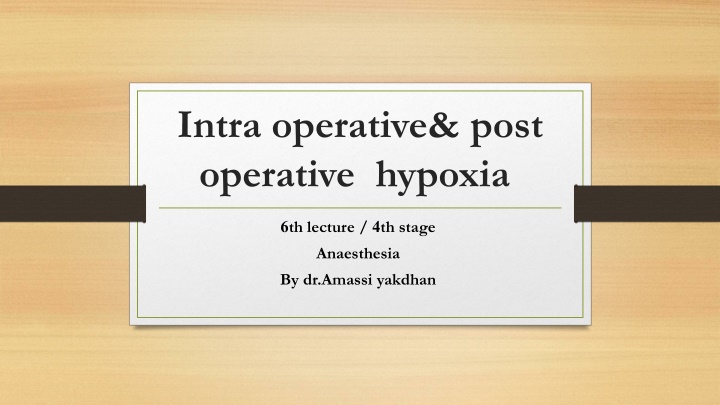
Managing Intraoperative and Postoperative Hypoxia in Anesthesia
Learn about the definitions of hypoxia and its various types, causes, and management strategies during intraoperative and postoperative stages of anesthesia. Explore the importance of oxygen delivery, patient-related factors, and preventive measures to address hypoxia effectively in clinical settings.
Download Presentation

Please find below an Image/Link to download the presentation.
The content on the website is provided AS IS for your information and personal use only. It may not be sold, licensed, or shared on other websites without obtaining consent from the author. If you encounter any issues during the download, it is possible that the publisher has removed the file from their server.
You are allowed to download the files provided on this website for personal or commercial use, subject to the condition that they are used lawfully. All files are the property of their respective owners.
The content on the website is provided AS IS for your information and personal use only. It may not be sold, licensed, or shared on other websites without obtaining consent from the author.
E N D
Presentation Transcript
Intra operative& post operative hypoxia 6th lecture / 4th stage Anaesthesia By dr.Amassi yakdhan
Definitions Hypoxia : failure of good oxygenation of body tissue. Anoxia : an organ not get O 2 Hypoxaemia : PaO2 less than 80 100 mmHg Hypoximic hypoxia : in sufficiant O2 reach to blood Circulatory hypoxia : in sufficiant blood reach to tissue Anemic hypoxia : in sufficiant HB to carry O 2 Histotic hypoxia : in ability of tissues to utilize O 2 -
O2 travilling Air lung. doolb . diffusion tissue Ventilation transportation External respiration internal respiration O2 supply O2 usage
Hypoxia not related to patient O2 delivery : O2 supply main port Obstruction : breathing circut from ventilator to ETT inside : foreign body , secretion Disconnection Kinking ETT Ventilator problems : In correct setting Mechanical problem in the ventilator
Hypoxia patient related Bronchospasm Atelactasis Pulmonary edema Pulmonary embolisim Penumothorax Penumonia Chronic diseases of parynchema : Obstructive or distructive lung disease Hypoventilation : In adequate reversal for muscle relaxant Systemic effects : septisemia , metabolic disorders , opioid over dose. air way resistance
Management of intra operative Hypoxia Clinicaly : Cynosis Dark blood field Desaturation Sympathetic stimulation Vital signs Prevention : check all alarms of the devices Check O2 delivery & percentage from source to patient Check any leak or damage to the ventilator or breathing circurt SPO 2 HR
Management of hypoxia during operation Check by stethoscope ? air way entery equal & bilateral Check ? if any abnormal sounds : wheezing in airway or noitatiperc amehcnyrap ni gnikcarc ekilor poor air entery Check connections of device If you are in doubt , change your ETT FiO2 Bimannual +ve ventilation Treat the under lying cause according
In a simple way Check your ETT FiO2 Bimannual +ve ventilation Treat underlying cause
Causes of post operative hypoxia Upper airway obstruction by : tounge , foreign body , secretion , blood Pressure on neck by bleeding of surgical neck operation Hypoventilation : in adequant reversal of muscle relaxant , over sedation ( opioid over dose ) Cardiac causes as ischaemia O2 demand : fever , shivering ,malignant hyperthermia Lung : Minor distal atelactasis to sever atelactasis Pulmonary edema , embolisim , pneumothorax Hypovolaemia that cause shock Hypoventilation that caused by post operative pain espicially in upper abdominal & lower thoracic surgeries
Positioning : supine head 45 to secure the airway O2 therapy as nasal cannula Monitoring vital signs & crieteria of discharge Well pain management & controll
Thank you 2021/ 2022






















